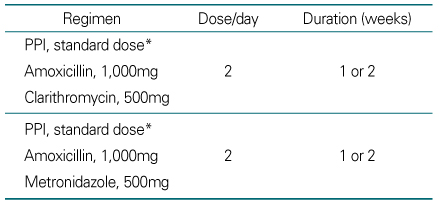 |
 |
- Search
| J Korean Med Assoc > Volume 49(11); 2006 > Article |
Abstract
Helicobacter pylori (H. pylori) causes chronic gastritis, peptic ulcer disease, primary B-cell gastric lymphoma, and adenocarcinoma of the stomach. The overall seroprevalence of H. pylori infection in Korea was 46.6%, and the seroprevalence increased with age and was highest in patients in their 40s. Only a fraction of people infected with H. pylori develop clinical disease. Mucosal inflammation is the basic mechanism underlying the disease development in which tissue destruction may be initiated and maintained by both the bacterial toxins and immune responses by the host. H. pylori infection can be diagnosed either by invasive techniques requiring endoscopy with biopsy (histological examination, culture, and polymerase chain reaction) or noninvasive techniques (urea breath test, serology, and detection of H. pylori antigen in stool specimens). The eradication of H. pylori infection is not easy and requires combinations of antibiotics. Even with the most effective treatment regimen currently available, the eradication is not successful in about 10~20% of patients. Seven-day triple therapy (proton pump inhibitor, amoxicillin, and clarithromycin) has been the first-line therapy for H. pylori infection in Korea. In case of failure, quadruple therapy (proton pump inhibitor, a bismuth salt, metronidazole, and tetracycline) is a very effective second-line regimen. If two or more eradication treatments fail, bacterial resistance to antibiotics should be evaluated and the regimen of third-line therapy should be selected according to the antimicrobial susceptibility results.
References
1. Graham DY, Sung JJ. In: Feldman M, Friedman LS, et al, editor. Helicobacter pylori. Sleisenger and Fordtran's Gastrointestinal and liver disease 2006;8th ed. Philadelphia: WB Saunders. 1049-1066.
2. Kim N. Epidemiology and transmission route of Helicobacter pylori infection. Korean J Gastroenterol 2005;46:153-158.
3. Kim JH, Kim HY, Kim NY, Kim SW, Kim JG, Choi KW, et al. Korea H. pylori Study Group, South Korea. Seroepidemiological study of Helicobacter pylori infection in asymptomatic people in South Korea. J Gastroenterol Hepatol 2001;16:969-975.
4. Kim NY, Kim JG, Kim JH, Kim HY, Kim SW, Choi KW, et al. Korean H. pylori Study Group, South Korea. Risk factors of Helicobacter pylori infection in asymptomatic Korean population. Korean J Med 2000;59:376-388.
5. Lee YC. Pathogenesis of Helicobacter pylori infection. Korean J Gastroenterol 2005;46:159-165.
6. Figueiredo C, Machado JC, Yamaoka Y. Pathogenesis of helicobacter pylori infection. Helicobacter 2005;10:Suppl 1. 14-20.
7. Yeo M, Hahm KB. Perspective of Helicobacter pylori research:molecular pathogenesis of Helicobacter pylori virulence factors. Korean J Gastroenterol 2005;46:181-188.
8. Hatakeyama M. Oncogenic mechanisms of the Helicobacter pylori CagA protein. Nat Rev Cancer 2004;4:688-694.
9. Machado JC, Pharoah P, Sousa S, Carvalho R, Oliveira C, Sobrinho-Simoes M, et al. Interleukin 1B and interleukin 1RN polymorphisms are associated with increased risk of gastric carcinoma. Gastroenterology 2001;121:823-829.
10. Machado JC, Figueiredo C, Canedo P, Pharoah P, Carvalho R, Sobrinho-Simoes M, et al. A proinflammatory genetic profile increases the risk for chronic atrophic gastritis and gastric carcinoma. Gastroenterology 2003;125:364-371.
11. Lee SW. Diagnosis of Helicobacter pylori infection. Korean J Gastroenterol 2005;46:166-171.
12. Laine L, Chun D, Stein C, El-Beblawi I, Sharma V, Chandrasoma P. The influence of size or number of biopsies on rapid urease test results: a prospective evaluation. Gastrointest Endosc 1996;43:49-53.
13. Midolo P, Marshall BJ. Accurate diagnosis of Helicobacter pylori. Urease tests. Gastroenterol Clin North Am 2000;29:871-878.
14. Nishikawa K, Sugiyama T, Kato M, Ishizuka J, Kagaya H, Asaka M, et al. A prospective evaluation of new rapid urease tests before and after eradication treatment of Helicobacter pylori, in comparison with histology, culture and 13C-urea breath test. Gastrointest Endosc 2000;51:164-168.
15. Tu TC, Lee CL, Wu CH, Chen TK, Chan CC, Lee MS SC, et al. Comparison of invasive and noninvasive tests for detecting Helicobacter pylori infection in bleeding peptic ulcers. Gastrointest Endosc 1999;49:302-306.
16. Gisbert JP, Abraira V. Accuracy of Helicobacter pylori diagnostic tests in patients with bleeding peptic ulcer: a systematic review and meta-analysis. Am J Gastroenterol 2006;101:848-863.
17. Vaira D, Gatta L, Ricci C, Miglioli M. Review article: diagnosis of Helicobacter pylori infection. Aliment Pharmacol Ther 2002;16:Suppl 1. 16-23.
18. Krogfelt KA, Lehours P, Megraud F. Diagnosis of Helicobacter pylori Infection. Helicobacter 2005;10:Suppl 1. 5-13.
19. Paimela HM, Oksala NK, Kaariainen IP, Carlson PJ, Kostiala AA, Sipponen PI. Faecal antigen tests in the confirmation of the effect of Helicobacter eradication therapy. Ann Med 2006;38:352-356.
20. Korean H. pylori Study Group. Diagnosis and treatment of Helicobacter pylori infection in Korea. Korean J Gastroenterol 1998;32:275-289.
21. Kim JG. Treatment of Helicobacter pylori infection. Korean J Gastroenterol 2005;46:172-180.
22. Chung WC, Cho YS, Jeong JJ, Lee IS, Kim SW, Park DH, et al. Eradication rate of Helicobacter pylori according to the diseases and therapeutic regimens, and reinfection rate after successful eradication in a tertiary clinic. Korean J Gastroenterol 2003;41:1-8.
23. Cho YJ, Chun HJ, Kim ST, Koh DW, Park JH, Hyun JH, et al. Analysis of eradication rate of Helicobacter pylori according to treatment duration by using 13C-urea breath test-comparison of OAC 7 , 10 , 14 days regimen. Korean J Gastrointest Endosc 2001;23:207-212.
24. Kim YS, Chun HJ, Choung RS, Kim KO, Kim YS, Hyun JH, et al. Helicobacter pylori eradication rate according to the duration of PPI based triple therapy-meta-analysis of the studies in Korea. Korean J Helicobacter Res Prac 2002;2:50-56.
25. Kim JM. Antibiotic resistance of Helicobacter pylori isolated from Korean patients. Korean J Gastroenterol 2006;47:337-349.
- TOOLS
-
METRICS

-
- 1 Crossref
- Scopus
- 1,263 View
- 9 Download
-
Related articles in
J Korean Med Assoc -
Bacteriological Characterisics of Helicobacter pylori Infection1997 September;40(9)
Epidemiology of Helicobacter pylori Infection in Korea1997 September;40(9)
Helicobacter pylori Infection and Gastroduodenal Disease ; Pathogenesis1997 September;40(9)







